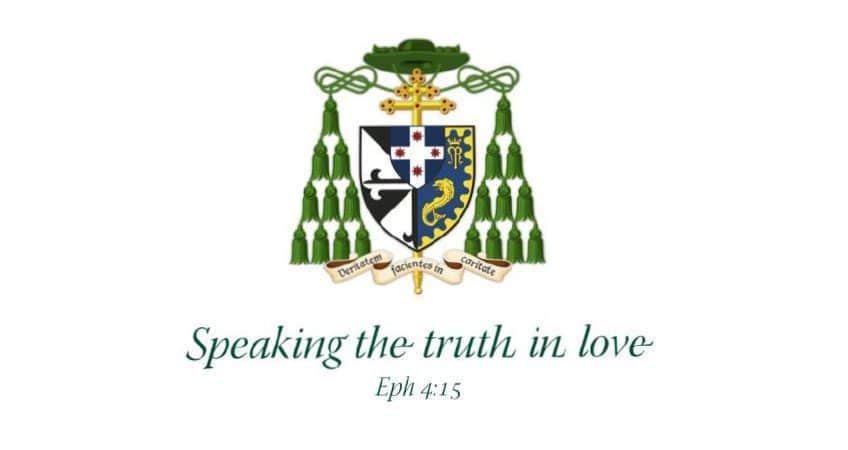HOMILY FOR MASS FOR THE 2ND SUNDAY IN LENT YEAR C + OPENING OF THE CATHOLIC INSTITUTE OF SYDNEY ACADEMIC YEAR

ST MARY’S CATHEDRAL, SYDNEY, 16 MARCH 2025
When it comes to the nuts and bolts of learning, there’s no shortage of opinions. Beginning in the mid-20th century, educationalists began to theorise and test different approaches, some very traditional, others highly experimental, and there are people who swear by each. Some approaches are clearly effective, but the jury is still out on what works best.
To give just a few examples of these pædagogical theories… Behaviourists regard the mind as a blank slate to be filled with stuff from outside: data, feedback, rewards, routines. Cognitivists think it comes more from within, and so focus on conceptualisation, reflection and retention processes. Constructivists believe learning is a brick-by-brick assembly, new knowledge building on top of old. Humanistic psychologists like Maslow say we must take care of ‘the whole person’ and their needs before trying to fill them with information or skills. And the new kids on the block, the Connectivists, think learning is primarily a partnership between humans and digital technologies. There are plenty of other approaches too, such as Transformative, Social and Experiential learning theories.
That the experts offer so many accounts of how it is that we learn things reflects the richness and mystery of the human person. We are not computers that perform functions through apps and data. Nor are we just animals driven by instinct or trained to do things on command. Rather we are composite beings, comprising body and soul, intellect and will, nature and nurture, given and chosen, altogether made in the image of God.
All of which makes teaching and learning more complicated than the frameworks suggest, but also more exciting. And whilst we can’t reduce learning to a single theory or simple process, we know there can be real knowledge gain and skills acquisition, and this involves many ingredients including ‘inspiration’ and ‘perspiration’, good methodologies, and trustworthy guides.
Today’s scriptures offer lots of ideas for those at the Catholic Institute of Sydney or elsewhere about how to go about teaching and learning. Abram learns about his mission (Gen 15:5-18) by looking at the stars and wondering, by reasoning from creation to a Creator, by contemplating his new-found faith and all he has received, and by freely choosing to respond. It’s a process, but it begins with trust in the God “in whom we live, and move, and have our being” (Acts 17:28), the God who unveils Himself to us in various ways, the God who gives us the mental equipment we need of perception and memory, imagination and will, faith and reason. Abram ultimately heeds the call to be a father, to take his family on a great adventure, to sacrifice all that is most precious to him, and so to be patriarch of the Chosen People and “our father in faith” (Eucharistic Prayer I; cf. Rom ch. 4; Gal ch. 3; Heb 6:13-15; 11:8-17).
Abram’s might seem to us a blind, unquestioning faith. So, too, Paul’s when he tells us today to model ourselves on good Christians like him (Phil 3:17-4:12). Trusting in God and the godly comes first for they are the best teachers. But there are some complementary counsels. Even Abram questions his inner voices or those outside. Paul, too, recognises that some apparently faithful Christians might actually be “enemies of the cross” and so discernment is required. And our Psalmist describes learning as a contest between darkness and light, danger and salvation. So we pose our questions and get some answers, learning with confidence but also humility, “taking heart” from our learning but being ready to revise what we think we know if better information or deeper wisdom comes our way (Ps 26(27)).
That our faith begins with trust but is not blind is perhaps most evident in our wonderful narrative of the Transfiguration (Lk 9:28-36). Sure, the apostles are following a good guide, Jesus that most reliable of teachers. But their journey with Him is still one of gradually having their eyes opened. At first, we hear today, their eyes are heavy and their perception cloudy. But then Christ enables their observations and reasonings to be inspired, purified and confirmed. He imparts that divine, transfiguring light we call faith. Not dark and blind but bright and intelligent faith. Understandably, Peter, James and John were awe-struck then dumbstruck. Yet they do not look away and cover their faces, as Moses did. No, Jesus allows the radiance of his graced humanity and gracing divinity to shine forth for them to see. Flanked by the Law and Prophets, He reveals that in His very person salvation history is brought to completion and our new history begins.
Those first disciples, and all of us since, hear from God the Father that “This is my beloved Son, the Chosen: listen to Him.” We each have our Abram moment, Moses moment, Peter, James and John moment, of realising who God is and who we are in relation to Him. But we are not autodidacts and finding God is not just a private pursuit. We learn to live as Christians from those “models” who are Christ’s faithful, by studying those already living as true disciples and imitating them in holding fast to Christ. We do so in the hope, expressed by Paul today, that our lowly bodies and minds will be transfigured into copies of Christ’s.
Dear friends of the Catholic Institute of Sydney, at the end of our Gospel we hear that “the disciples kept silence” about what they had seen and “at that time, told no one”. At that time they kept quiet, but in due course they would tell the stories of this event and write them down, would preach on its significance, sharing their conviction that Christ’s transfiguration was not for His sake but for ours—a promise to us all. After interrogating our experience and thinking, after learning, digesting and contemplating, the time comes to keep silence no longer, to share with others, to teach. That is the task of our Institute, in its research and classes, in the academic community it seeks to build, and in the enlightenment it seeks to impart. Together we pray for your success, so that people’s faith and knowledge may be deepened, so that priests, deacons, religious and lay people prepared, so that the Good News be spread far and wide, and so that God’s kingdom comes—to Sydney and beyond. May the light of the transfigured Christ illuminate your hearts and minds, your teaching and learning!
INTRODUCTION TO MASS FOR THE 2ND SUNDAY IN LENT YEAR C + OPENING OF THE CATHOLIC INSTITUTE OF SYDNEY ACADEMIC YEAR – ST MARY’S CATHEDRAL, SYDNEY, 16 MARCH 2025
Welcome to St Mary’s Cathedral for our Solemn Mass of the Second Sunday of Lent. Today we mark the beginning of the 2025 Academic Year for the Catholic Institute of Sydney, the archdiocese’s own theological institute. I acknowledge concelebrating with me: Most Rev. Bishop Richard Umbers, Deputy Chancellor of the Institute; with Vicar General Very Rev. Fr Sam Lynch; and several brother priests;
From the Seminary of the Good Shepherd: Rector Very Rev. Fr Michael De Stoop, joined by Rev. Fathers Paul Durkin, John Armstrong and Dominic Nguyen, along with their seminarians;
From the Redemptoris Mater Seminary: Vice Rector Fr Marlon Henao Perez, and seminarians;
From the faculty of the Institute: Most Rev. Bishop Danny Meagher, and Very Rev. Fathers Peter Williams VG, Rev Dr. Luke Holohan SM, Very Rev. Dr Julian Wellspring, and other members of faculty; and
From Vianney College, Wagga Wagga: Rev. Fr Bradley Rafter.
I welcome the newly appointed President of the Institute, Professor Hayden Ramsay, who will today make his Profession of Faith upon assuming office. I acknowledge the wonderful work of Professor Sr Isabell Naumann ISSM in leading the Institute over the last seven years, and of Rev. Dr Gerard Kelly for leading it for years before that! I welcome Deputy President and Academic Dean, Prof. Rohan Curnow; along with senators, faculty, staff and students.
I greet from our partner University of Notre Dame Australia: Prof. Renee Kohler-Ryan, along with other faculty; and I recognise friends from other Catholic tertiary institutions, including the Vice Chancellor of the Australian Catholic University, Prof. Zlatko Skrbis; and the President of Campion College Australia, Dr Paul Morrisey. I salute Clr John-Paul Baladi, Mayor of Strathfield, where the Institute is situated; and other distinguished guests.
We welcome the encouraging news regarding Pope Francis’ health and continue to pray that the God of comfort and healing be with him during this time.
To everyone present, including visitors and more regulars, a very warm welcome to you all!

